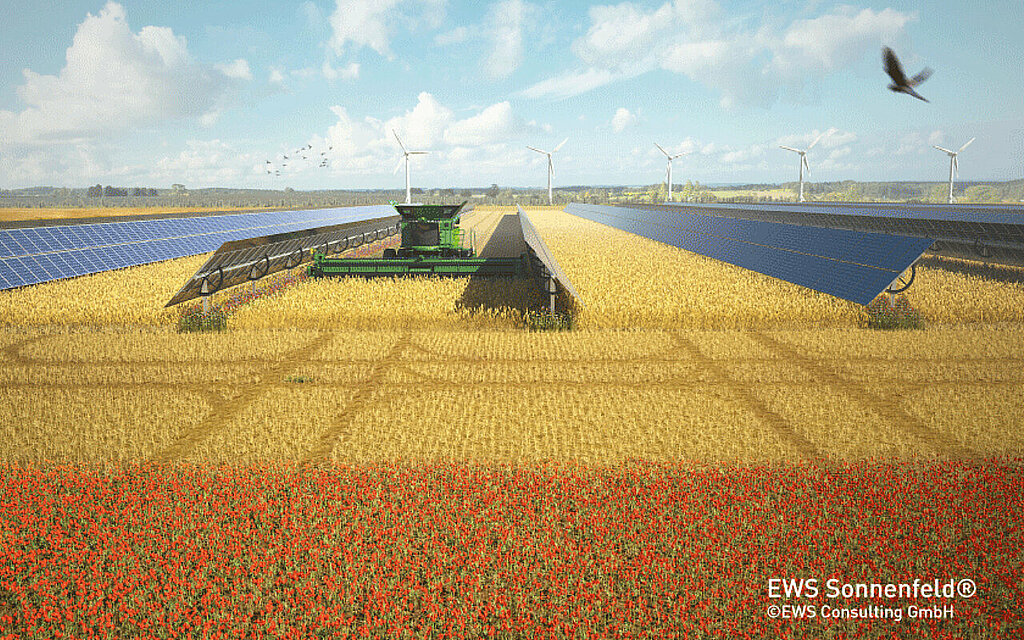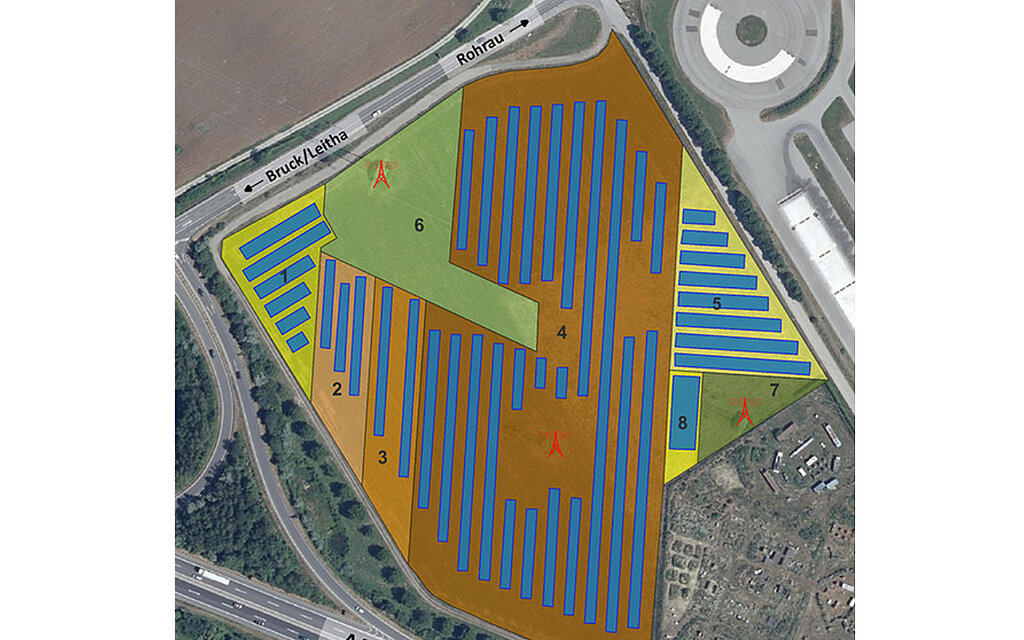Agri-PV future technology: how meteocontrol is helping with the market launch
The hot topic of agri-photovoltaics is seen as an innovative way out of the dilemma that open-field systems can only serve one purpose: agriculture or photovoltaics. Agri-PV resolves this land-use conflict and turns the “or” into an “and” – meaning that food and solar power can be produced on the same land.

This dual ‘management’ of land promises additional revenue for operating companies and synergies for agriculture. Horizontal PV systems protect crops from the effects of global warming, such as hail, heavy rain, drought or sunburn, rather like a roof.
On the other hand, there are challenges, because agri-PV increases technical complexity: both the photovoltaic system and agricultural cultivation become more complicated. The planning and construction of PV systems become more complex and costly. The planning and installation of each agri-PV system is matched to the plant culture and the agricultural machinery to determine a practicable cultivation width. This requires twice the knowledge and expertise – detailed questions can generally be clarified in practice as close to the application as possible and validated in accompanying studies.
The opportunities and obstacles offered by agri-photovoltaics are more than enough reason to undertake further research and test this future technology.
The expert judging panel of the Austrian Climate and Energy Fund were clearly of this opinion when they awarded funding to the “EWS Sonnenfeld Bruck/Leitha” research and demonstration installation as a photovoltaic model and lighthouse project. The project was planned and developed by EWS Consulting GmbH and installed together with Energiepark Bruck/Leitha GmbH as the project partner. Vienna University of Natural Resources and Life Sciences is conducting research on the 3-megawatt agri-PV system, which was connected to the power grid in November. The system was equipped with meteocontrol measuring and monitoring technology for this purpose.
Promising innovations
The agri-PV concept is versatile: there are multiple variations, from flat or upright, horizontally or vertically mounted modules, to various arable crops and special crops, such as herbs, wine or fruit. Some of these permutations are already being tested and scientifically managed. Many of them have already found their way into practice.
The EWS Sonnenfeld Bruck/Leitha demonstration facility boasts special design features:
- It focuses on biodiversity. Two-meter wide flowering strips have been planted below the modules, which together account for 18% of the total area. These areas are difficult to manage anyway. In agri-PV systems, species-poor monocultures are often used – especially in conventional agriculture.
- They have module tables, mounted at a height of 2.8 metres that can be swivelled. This allows their angle of inclination to be automatically aligned to the path of the sun, thereby increasing electricity yields. These same module tables can also be positioned upright on harvesting days to provide room for harvesting machinery.
See the Sonnenfeld system with its swivelling module tables and soil cultivation with a cultivator in action in this video.
The research design behind the Lower Austrian demonstration plant is also interesting: their scientists are investigating the correlations between electricity generation and agriculture. Different models are therefore being tested on the 5.1-hectare site and their performance evaluated.
The following is being tested:
- cultivation widths of 6, 9 and 12 metres with tracking systems
- fixed module tables with various inclinations and orientations
- additional yields from bifacial modules and performance optimisers
The agricultural yield beneath the various PV models is compared with an uncultivated field, and the biodiversity of all agri-PV systems with fallow land. Measuring technology is required to collect the data on these scientific investigations.

meteocontrol measuring and control technology
meteocontrol is measuring and processing both solar and agricultural data in agri-photovoltaics. This will help to optimise the yields of the PV system, ensure its reliable operation, and collect research data.
The Sonnenfeld site and the reference fields have therefore been equipped with various sensors and measuring instruments, all of which are connected to the meteocontrol VCOM Cloud platform. Use of a compact weather station (WS600-UMB) measures parameters, such as precipitation, wind speed, wind direction and temperature. Other sensors detect the availability of water in the soil that can be used by the plants, the intensity of partial shading, and photosynthetically active radiation.
Ideematec's tracking system for automatic module alignment to the angle of solar radiation actively communicates with the meteocontrol Power Plant Controller (blue’Log®), which collects data from externally connected sensors. This enables the modules to be automatically positioned upright at high wind speeds, which protects them from the force of the wind.
How widespread is agri-photovoltaics?
While there is still a need for research, agri-PV is nevertheless already used in practice: according to estimates by the Fraunhofer Gesellschaft, some 14 GWp of power is already installed worldwide, which equates to roughly 2% of all PV installations. Most of these installations are located in China (12 GWp). Small agri-PV systems are used in Japan and South Korea, over 3,000 of which were installed in Japan in 2022. In France, 15 MWp of agri-PV systems have been tendered annually since 2017. meteocontrol itself has fitted agri-PV systems with monitoring and control technology in Germany (2.5 MWp in Freising with oxen grazing on the open field) and France (2.4 MWp in Amance, Haute-Saône, with crops such as soya and cereals being grown).
In Germany, a number of practical systems were installed as a result of the German innovation tendering process alongside research installations. The EEG 2023, German Renewable Energy Sources Act, states that agri-PV installations must be included in the same tenders as solar parks and be awarded a technology bonus of 1.2 cents per kilowatt hour. However, according to the German Farmers' Association, the Fraunhofer ISE, and Kehl University of Applied Sciences, this is by no means sufficient to achieve a significant expansion of ground-mounted systems. The agri-PV inventors based in the town of Munderfing in Austria see great potential: “In Austria, we can generate 17% of our total electricity consumption on agri-PV fields and produce food at the same time” explains Joachim Payr, Product Developer of the EWS Sonnenfeld®.
The market launch of agri-PV and resolution of land-use conflicts largely depends on the respective political situation. Without support, the main expansion of photovoltaic systems will continue to be only in the form of roof-based systems and solar parks. Whether this will change in the medium term depends on the general conditions, but also on industry pioneers and the increased knowledge and expertise acquired from demonstration installations, such as the EWS Sonnenfeld in Bruck/Leitha.
Read more about the topic: EWS Sonnenfeld: News: 17 % of total electricity consumption in Austria can come from Sonnenfeldern (Agrivoltaics)